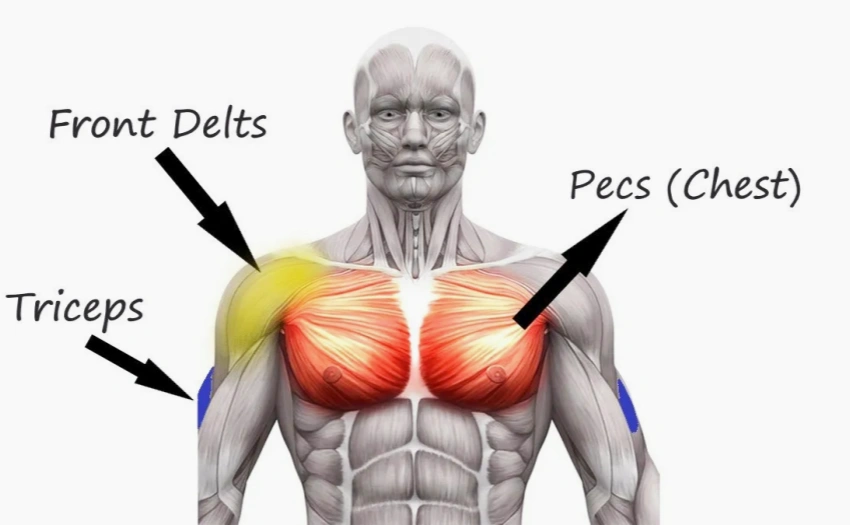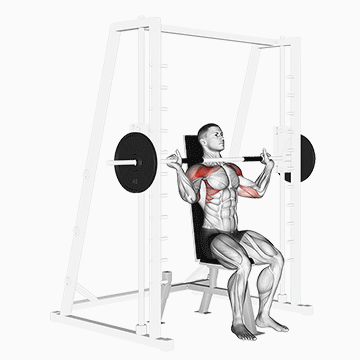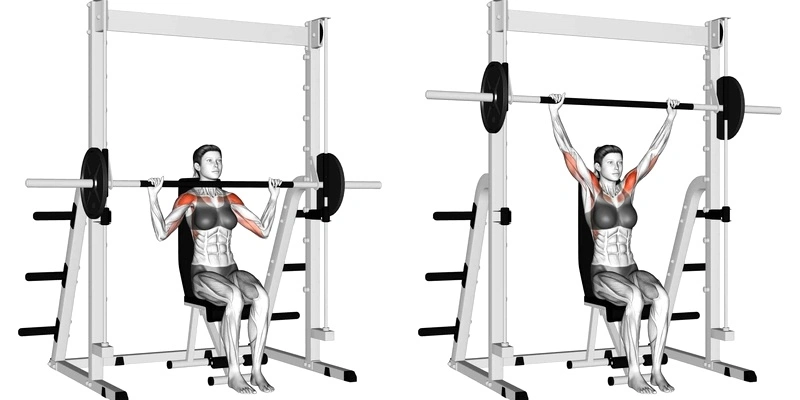Smith Machine Overhead Press. A shoulder day classic.
Basically, it’s a shoulder press on the Smith machine. Fixed bar path. No worrying about the bar drifting.
Feels steady. Feels safe.
Why it’s good? Plenty of reasons. Beginners don’t have to stress over form. Advanced lifters can push heavier. You focus on pressing. The machine takes care of the rest.
And that burn in your shoulders when you lock it out? Feels so good.
So, let’s break it down. Here’s how to make the most of this move.
Smith Machine Overhead Press Quick Overview
The Smith Machine Overhead Press is basically a shoulder press on a Smith machine. You push the bar straight up, and the machine’s rails keep it moving in one fixed line. No balancing act. No wobbles. Just you, the bar, and your shoulders doing the work.
You can do it sitting or standing, depending on what feels right.

Target muscles:
- Front delts — main pressing power
- Side delts — adds width and shape
- Triceps — helps lock out at the top
- Upper traps & core — stabilize the lift
Benefits:
- Stable and controlled — no wobble
- Consistent form — same path every rep
- Beginner-friendly — easy to learn
- Safe heavy pressing — focus on muscle, not balance
How to Do Smith Machine Overhead Press
Smith Machine Overhead Press looks simple. But the way you move — the rhythm, the control — that’s what makes the difference. Get it right, and your shoulders will light up in the best way.

✅ Step 1 – Setup
Walk up, adjust the seat if you’re sitting. The bar should be around upper chest height. Grip just a bit wider than your shoulders — enough room to press without straining your wrists.
✅ Step 2 – Get in position
Sit or stand tall. Wrists stacked over elbows. Core tight. Feet planted like you mean it. You should feel stable before the first rep.
✅ Step 3 – Press
Push the bar straight up. Smooth. Controlled. About 2 seconds on the way up. Breathe out as it rises. Stop just before your elbows lock. Hold at the top for 1–2 seconds — feel that squeeze in your shoulders.
✅ Step 4 – Lower
Bring it down slowly, about 3 seconds. Keep the bar path steady. Stop at chin or collarbone height — low enough to work the muscle, not your joints.
✅ Step 5 – Repeat
Same rhythm, every rep. Don’t rush. Let the muscle do the work, not momentum.
Avoid:
- Leaning back like you’re in a recliner.
- Dropping too low and straining your shoulders.
- Elbows flaring out like chicken wings.
Smith Machine Overhead Press Workout Plans
Different goals, different ways to use the Smith Machine Overhead Press. You don’t need a fancy plan — just match your reps, weight, and pace to what you want.
Here’s the simple cheat sheet:
| Goal | Sets × Reps | Weight | What to Focus On |
|---|---|---|---|
| Strength | 4–6 reps × 4–5 sets | Heavy — last rep feels like work | Add a small plate (2.5 kg) every week or two. Keep reps clean. |
| Muscle | 8–12 reps × 3–4 sets | Moderate — burning by last 2 reps | Try pyramid style: start light, add weight each set, then drop weight for a burnout. |
| Endurance | 12–15 reps × 3–4 sets | Light to moderate — smooth all the way | Superset with side raises or front raises. Minimal rest for max pump. |
No matter the goal:
- Brace your core — tight like you’re about to take a punch.
- Push the bar up in about two seconds, pause for a quick one–two count at the top, then lower it slowly for around three seconds.
- Keep it smooth and steady. The machine helps with stability — you focus on the squeeze.
So, now you’ve got your plan. Heavy and low reps if your focus is strength training. Moderate weight if you’re aiming for muscle. Light and higher reps for endurance. Easy to remember, right?
The Smith Machine Overhead Press is simple, steady, and safe. The bar stays on track, so you just focus on pushing.
Go with the style that matches your goal. Keep that form locked in, and nudge the weight up bit by bit. Stick with it for a few weeks — you’ll notice your shoulders feeling stronger, looking more solid.

Hi, I’m Alex Carter, part of the editorial team at Leadman Fitness. We specialize in crafting premium custom racks, cable machines, functional trainers, and strength accessories for home and commercial gyms. With a background in competitive powerlifting and gym design consulting, I’ve spent years testing gear under heavy loads and optimizing layouts for efficiency.
I focus on translating real-world user frustrations—like space limitations, budget constraints, or durability needs—into actionable solutions. By collaborating directly with our engineers and facility owners, I ensure our custom equipment evolves to solve the unspoken challenges lifters face daily. What I share isn’t textbook advice; it’s battle-tested insight from racks I’ve welded, cables I’ve replaced, and gym floors I’ve trained on.
